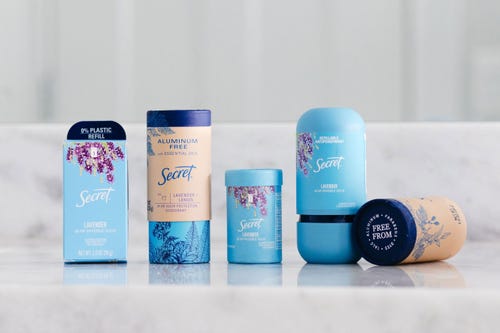How Procter & Gamble is Making Its Deodorant Portfolio More Sustainable

Cincinnati-based Procter & Gamble (P&G) is advancing its sustainability efforts with the launch of refillable antiperspirant cases that eliminate single-use plastics for its well-known deodorant brands.
Following a May 2020 successful pilot which included an all-paper, plastic-free solution, the company's Secret and Old Spice brands are now offered with an aluminum-free formulation and in recyclable paper tube packaging made of 90% recycled paperboard, certified by the Forest Stewardship Council (FSC).
The new deodorant tubes feature a "signature push-pop" design that can be placed in a consumer's recycling bin once it reaches the end of its useful life.
“People are craving more eco-friendly personal care products, but they also must be delightful to use, otherwise people will not stick with them long term,” said Anitra Marsh, vice president, sustainability, citizenship and communications, P&G Beauty. “That is why our refillable antiperspirant cases are designed to advance the antiperspirant smoothly through the case with a simple twist, much like a lipstick, without being messy.”
Marsh told Waste360 about the new packaging design launch and its P&G's work with various partners to end single-use plastic waste.
With Americans being more intentional with their purchasing decisions, what was the process from the time of making the decision to designing the newer packaging options for the deodorants?
Our main focus was working through multiple potential solutions that could help provide sustainable choices to consumers when shopping for personal care products. From there, we moved into a test and learn program, initially launching last year in a limited run to understand how consumers felt about paperboard packaging for their deodorants. Based on the success of that launch, we expanded to nationwide availability. We also chose to roll out refillable antiperspirants as an additional choice for consumers looking to make sustainable choices but want the sweat and odor protection an antiperspirant offers.
Did P&G explore any other packaging materials during the design process? What factors were considered?
We are always considering new packaging options, new materials, new business models, supply chains, and even material availability on our journey to move towards our company goal of 100% recyclable packaging by 2025. Having a test and learn approach allows us to see how consumers like the new packaging before rolling out on a national level.

What kind of consumer research was completed to come to a price point that was comfortable?
Pricing is at the sole discretion of retailers. Still, we firmly believe that in order to allow as many consumers as possible to opt-in for a sustainable choice, it must be affordable. We’re proud to have one of the most affordable refills on the market and the only refillable antiperspirant from a mass brand.
What opportunities does the paper-based packaging solution provide to P&G in terms of being able to apply it to other products?
Paperboard packaging for deodorants is available for Secret, Old Spice and Native. We also use paperboard tubes on our antiperspirant refills for Secret and Old Spice.
Can you please explain the sustainability factors of paperboard packaging?
Paperboard is highly recyclable and also widely collected in the United States. Consumers need only crush the paperboard canister and toss it in their recycling bin. Our Paperboard packaging is made with FSC-certified paperboard that is 90% post-consumer recycled paper. Just in case the paperboard tube is not recycled, it can decompose in as little as a few months.
Why is producer responsibility so important when it comes to designing sustainable solutions?
P&G is providing recyclable and reusable products and partnering with leading organizations to increase recycling rates at home and in local communities. About 90% of P&G product packaging is either recyclable, or there are programs in place to create the ability to recycle it. We are working with The Recycling Partnership to make it easier for people to recycle in their community through educational resources and technical assistance and joined Beyond 34 to help increase the baseline 34% recycling rate in the U.S. by improving local recycling systems. The paperboard deodorants are a great example of a product that consumers can easily recycle at home, simply crushing the tube and dropping it into their local recycling bin.
Is P&G part of any consortiums, partnerships or collaborative groups to improve sustainability in consumer goods?
P&G is using our size, scale, and expert partners to help create solutions that help keep waste out of nature. To revolutionize the recycling process, we’re working with more than 120 companies on HolyGrail, which uses game-changing digital watermarks embedded in packaging to ensure higher-quality recycling and more accurate and efficient sorting of recyclables. With PureCycle, we’re expanding the reuse potential of recycled plastic waste to give it new life. As a founding member of the Alliance to End Plastic Waste, we’re working with over 50 companies to end plastic waste in the environment through programs and partnerships.
What does packaging look like for P&G in the next 5-10 years?
By 2030, P&G will offer 100% reusable or recyclable packaging and reduce the virgin petroleum plastic in our packaging by 50% against a 2017 baseline. Since 2010, P&G has avoided the use of more than 200,000 metric tons of packaging and doubled the use of recycled resin in our plastic packaging. We continue to innovate, test options with consumers, and roll out solutions, like these paperboard deodorants and refillable antiperspirants, as broadly as possible.
About the Author
You May Also Like




.png?width=300&auto=webp&quality=80&disable=upscale)